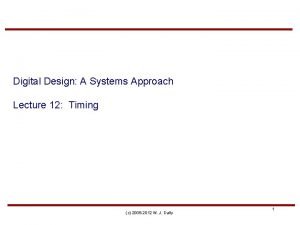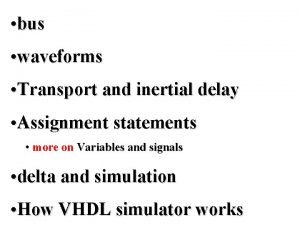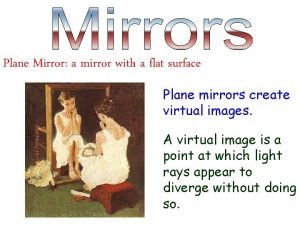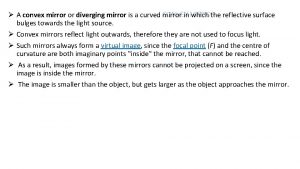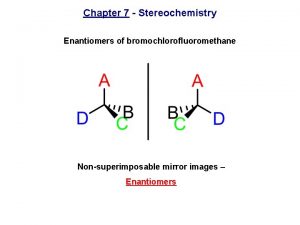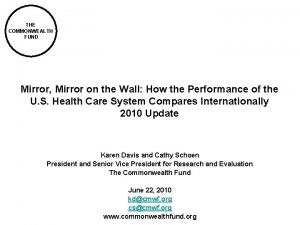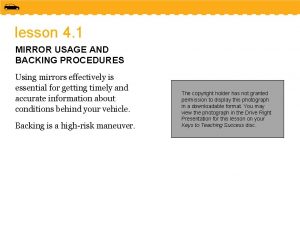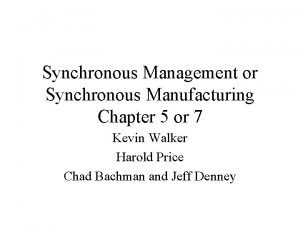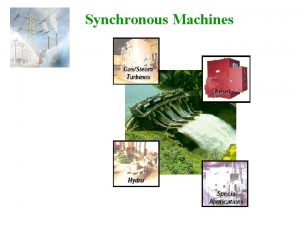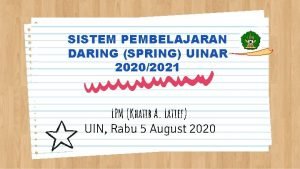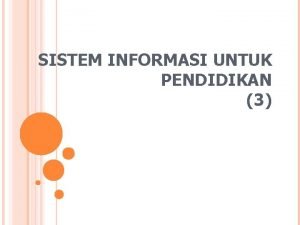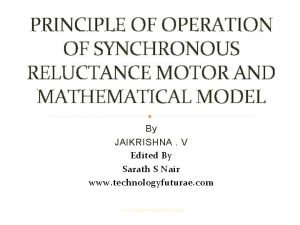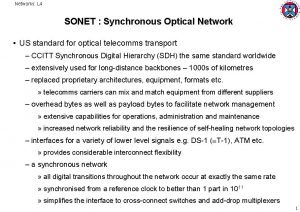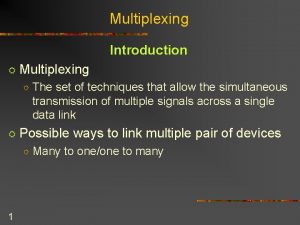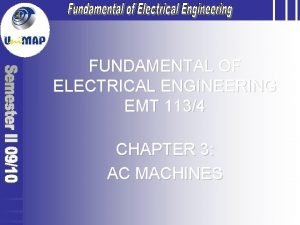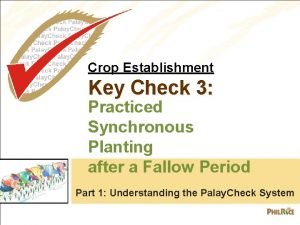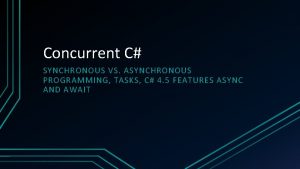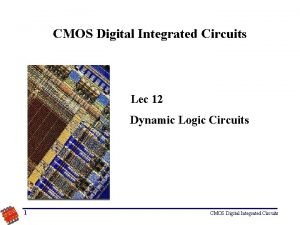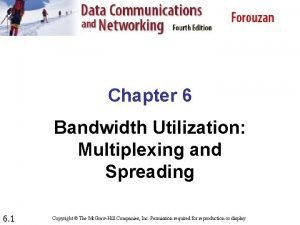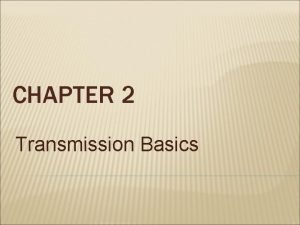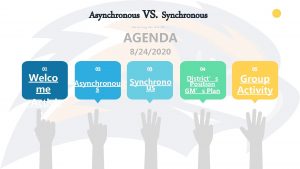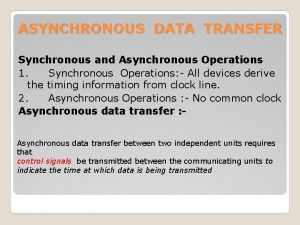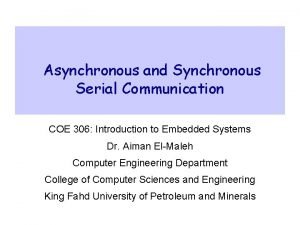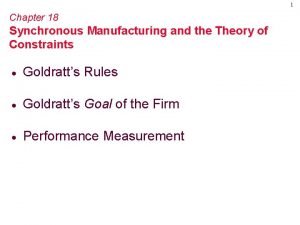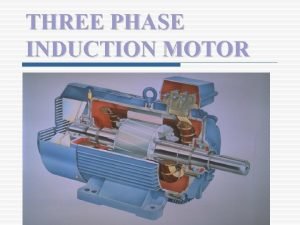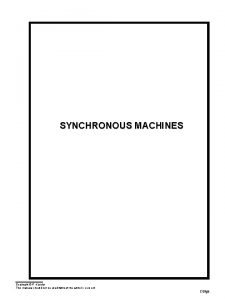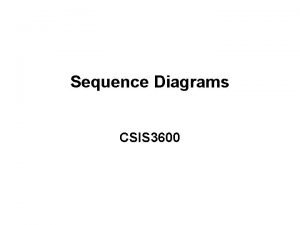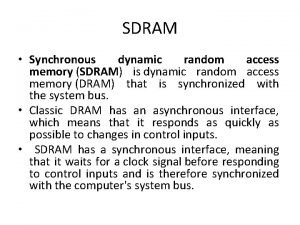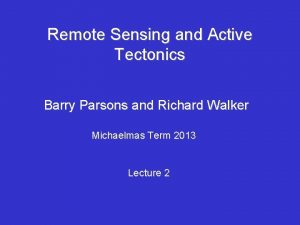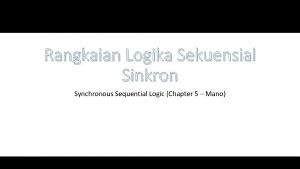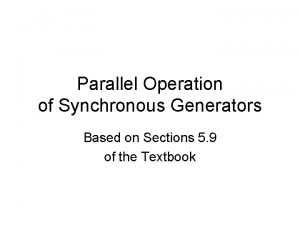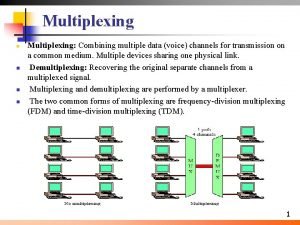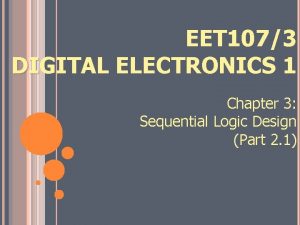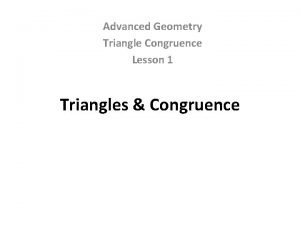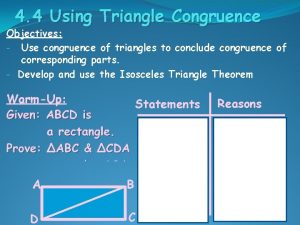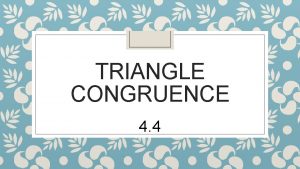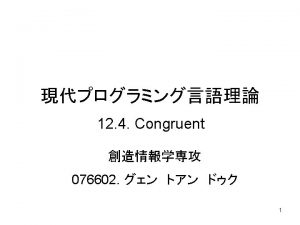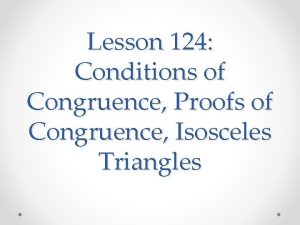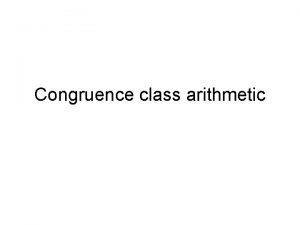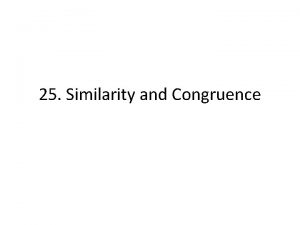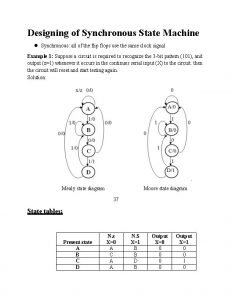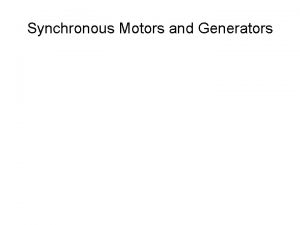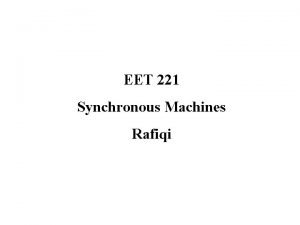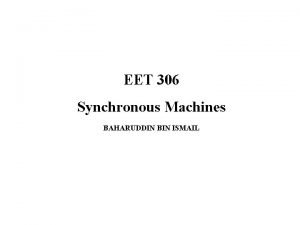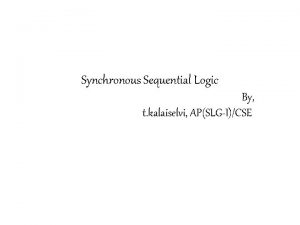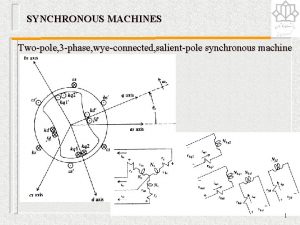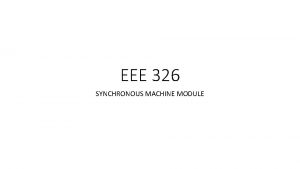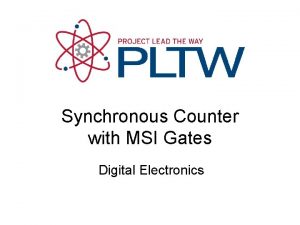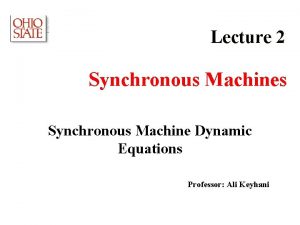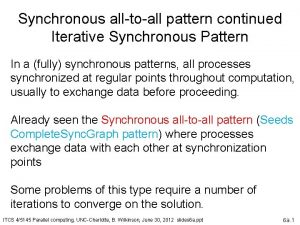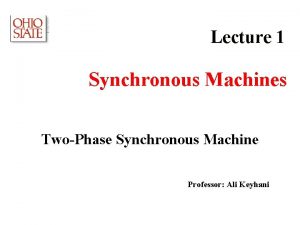Congruence Structure of Synchronous Mirror Delay As a










































- Slides: 42

Congruence Structure of Synchronous Mirror Delay As a Case of Research Method for Students in CSIE Tsung-Chu Huang Dept. of Electronic Eng. National Changhua University of Ed. Email: tch@cc. ncue. edu. tw 2004/12/15 Talk@CSIE. DYU TC Huang, NCUE 2004/12/15

Outline • • • Introduction Previous Work Proposed Congruence SMD Structure Experimental Results Applications of Proposed SMDs Conclusion and Future Work TC Huang, NCUE 2004/12/15 2

Time Clausure T Q D Q D setup hold C TC Huang, NCUE 2004/12/15 3

Jitter & Skew Jitter Q D Q D Skew Clk TC Huang, NCUE 2004/12/15 4

Problem Formulation Trench Cell Bit Word Strobe Generator (Edge Detector) Typical Synchronous DRAM TC Huang, NCUE 2004/12/15 5

Problem Formulation Strobe Generator (Edge Detector) IB Constant Skew Do Typical Synchronous DRAM TC Huang, NCUE 2004/12/15 6 D 1

Conventional SMD r er e f t u p n I CLKext IB f u B k c lo riv D C CD CLKint Skew TC Huang, NCUE 2004/12/15 7

Conventional SMD CLKext IB CD PLL CLKint Several hundred cycles of locking time 1. Lowering speed 2. Make shutdown difficult in power management 1. Especially for clock-gating system, and 2. High-speed SDRAM in prefetch TC Huang, NCUE 2004/12/15 8

Conventional SMD CLKext IB IB CD Forward Delay Array CD Mirror Control Circuit Backward Delay Array CD CLKint Very Fast Locking Time (Saeki, JSSC, Nov. ’ 96. ) TC Huang, NCUE 2004/12/15 9

Major Previous Work • Saeki’s Digital SMD, 1996 – Only for SDRAM, with extra driver • Shim’s Analog SMD, 1999 – Accurate, high power, also 2 -cycle locking • Saeki’s Direct-skew-detect SMD, 1999 – Direct-skew-detect, also for ASIC, without extra driver, low power • Sung’s Interleaved SMD, 1999 – Double SMD circuits to use the double edges in interleaved way. • Yoo’s Open-loop Clock De-skewing Circuit, 2003 – No delay measure line, high area and power overhead due to flip-flops, difficult to matched. • Wang’s Half Delay Line Skew-Compensation – Assume duty=50%, utilizing negative edges and bit-reversing, with FFs and MUXs. . . TC Huang, NCUE 2004/12/15 10

Delay Mirror Circuit in Both Conventional and Direct-Skew-Detect SMDs Fanout=2 TC Huang, NCUE 2004/12/15 11

Unit of Most Conventional SMDs Matched Loading and Layout 12

Conventional SMD (SMD) Relative Resolution TC Huang, NCUE 2004/12/15 #Stages of SMD Units 13

Timing Diagram 14

Application of SMD in SDRAM TC Huang, NCUE 2004/12/15 15

Direct-skew-detection SMD (DSMD) TC Huang, NCUE 2004/12/15 16

Interleaved SMD (ISMD) TC Huang, NCUE 2004/12/15 17

Half Delay-line Skew Compensation (HDSC) TC Huang, NCUE 2004/12/15 18

Number of Delay-line Cells Major Cost: Power Dissipation and Area Overhead Proposed + Control Ckt + Unbalanced Risk HDSC ISMD DSMD TC Huang, NCUE 2004/12/15 19

Why Not Counting the Skews? • General up/down counters are FSMs that the NS depends only on PS. They include binary, Gray, ring, Johnson counters and LFSRs. • We can count the running pulse around a delay loop and then down-count to mirror the delay. • However, – The clock of the counter with a much higher frequency may conflict the setup/hold time and even the inertia properties. – The flip-flops and multiplexers are difficult to be designed in matched layout or even rise/fall balance. TC Huang, NCUE 2004/12/15 20

Design Philosophy: General Counters/Timers • General counters are FSMs those next states are only dependent on their present states: – Classified by Numeric Theory: • Modulo System • Congruence System – Classified by Triggers: • Clocked: for example, using FFs – Binary, Gray, Johnson, Ring, LFSR, etc. • Waved: for example, using delaylines TC Huang, NCUE 2004/12/15 Easier for matched layout and balanced design for intra-setup-time progression. 21

Congruence Theorem • Theorem 1: Congruence Theorem X≡R (mod M) X≡R (mod N) →k: integer, X = k lcm(M, N)+R TC Huang, NCUE 2004/12/15 22

Counter-Congruence • Theorem 2: Counter-Positive Statement If min(M, N)<T< lcm(M, N) T≡Rm (mod M) T≡Rn (mod N) →Rm≠Rn TC Huang, NCUE 2004/12/15 23

Zero-Jitter Congruence Structure X TC Huang, NCUE Dummy 2004/12/15 24

Counter-Congruence with Error • Theorem 3: in Linear Error Accumulation If gcd(M, N)=g, M=mg, N=ng, gcd(m, n)=1, e<g/2 T, where T is the running time (point); min(M, N) g < T(1 -e) < {X, Y} < T(1+e) < lcm(M, N) X≡Rm (mod Mg) Y≡Rn (mod Ng) →Rm≠Rn TC Huang, NCUE 2004/12/15 25

Proposed Congruence Structure 26

Constraints for Running Pulse with Skew • Inertia Delay through Edge Detector • Error Accumulation – Considering only the delay loops when d 1+d 2<<T – Assume r: delay of a nor gate, and d: delay of a SMD unit; d=2 r TC Huang, NCUE 2004/12/15 27

Constraints for Running Pulse with Skew • Inertia Delay through Arrival Detector If X pulse returns back at T X Y If Y pulse returns back at T TC Huang, NCUE Example: Assume e≈0. 1%, a=r=10 ps, T≈4 ns, g=2 is selected. About 300 stages are selected for conventional SMD. Let m=17, n=15; a higher resolution is achieved and the area reduction will be more than 80%. 2004/12/15 28

Counterparts and Integration • Duals: – Positive edges: • Matched-Layout NOR 2 -NOR 2 Delay Cells • NAND 2 -NOT Mirror Cell – Negative edges: • Matched-Layout NAND 2 -NAND 2 Delay Cells (NAND 2 is smaller). • NOR 2 -NOT Mirror Cell • Integration: – Double-Edge Interleaving – The Backward Delay Loops can be saved if Wang’s Bit. Reversing Control Structure is used. TC Huang, NCUE 2004/12/15 29

Experimental Plan Using the Fundamental Ability of Students in CSIE Adjust #stages, #inv, m, n, g Using C-Scripts System. Call. C NCSim Function Correct? V 2 SP. C LIB/Model TC Huang, NCUE HSpice 2004/12/15 30

Experimental Results • Function is validated by – NCVerilog with max/min delays (in 0. 1% errors). – HSPICE using TSMC/0. 18 um Technology. • Current Results – g=2, (m, n)={(5, 7), (7, 8), (15, 17), …}, – f: 100 MHz~400 MHz TC Huang, NCUE 2004/12/15 31

Simulation Result 32

Simulation Result TC Huang, NCUE 2004/12/15 33

Comparison Design PLL DLL SMD ASMD ISMD DSMD HDSC Proposed Technology Analog Digital Digital Lock time >50 2 2 2 Power dissipation High Medium Low High Low Low Power switching Difficult Allow Allow Area Small Large Medium Small Accuracy High Medium Low Medium Dummy driver - - Yes - No No No Depends Length of delay line for Res. =300 - - ~300 - ~600 ~300 ~75 ~30 Pulse Matching - - No Positive Device ASIC SDRAM Both TC Huang, NCUE 2004/12/15 34

Conclusion • We propose a congruence structure for both conventional SMD and Direct-skewdetect SMD. • For relative resolution of lcm(m, n), related area and power dissipation can be reduced to g(m+n), where g is related to the delay error ratio. TC Huang, NCUE 2004/12/15 35

Applications and Future Work • Low-Power Test Scheduling – Fast locking allows clock generators to be shut down. • Jitter Measurement or PLL Testing • Deskew for clock-gating system • Built-in delay test or delay grading TC Huang, NCUE 2004/12/15 36

Application to PLL Jitter Measurement pdf TC Huang, NCUE 2004/12/15 37


Application to Token Scan Skew in a Token Scan Cell TC Huang, NCUE 2004/12/15 39

References 1. E. G. Friedman. Clock Distribution Networks in VLSI Circuits and Systems. Piscataway, NJ: IEEE Press, 1995. 2. J. Dunning et al. An all-digital PLL with 50 -cycle lock time suitable for high performance microprocessors. IEEE J. Solid-State Circuits, vol. 30, pp. 412 -422, Apr. 1995. 3. T. Saeki et al. A 2. 5 -ns clock access, 250 MHz, 256 -Mb SDRAM with synchronous mirror delay, IEEE J. Solid-State Circuits, vol. 30, pp. 1656 -1668, Nov. 1996. 4. T. Saeki et al. A Direct-Skew-Detect Synchronous Mirror Delay for Application-Specific Integrated Circuits. IEEE J. Solid-State Circuits, vol. 34, pp. 372 -378, Mar. 1999. 5. D. Shim et al. An Analog Synchronous Mirror Delay for High-Speed DRAM Application. IEEE J. Solid-State Circuits, vol. 34, pp. 484 -493, Apr. 1999. 6. V. Gutnik and A. P. Chandrakasan, Active GHz clock network using distributed PLL's, IEEE J. Solid-State Circuits, vol. 35, pp. 1553 -1560, Nov. 2000. 7. K. Sung et al. Low power clock generator based on area-reduced interleaved synchronous mirror delay. IEE Electronics Letters, pp. 399 -400, Vol. 38, Apr. 2002. 8. C. Yoo. An Open-Loop Clock Deskewing Circuit for High-Speed Synchronous DRAM. IEE Electronics Letters, Vol. 39, No. 1, Jan. 2003. 9. Y. -M. Wang and J. -S. Wang. A Low-Power Half-Delay-Line Fast Skew-Compensation Circuit. IEEE J. Solid-State Circuits, vol. 39, pp. 906 -918, June 2004. 10. Y. J. Yoon et al. Synchronous mirror delay for multiphase locking. IEEE Solid-State Circuits, Vol. 39, Jan. 2004 TC Huang, NCUE 2004/12/15 40

Rethink to This Innovation for CSIE Students • Basic Background on Circuit Design + Simple Numeric Concept + HDL Tools + C Scripts + Idea Ø Contributions TC Huang, NCUE 2004/12/15 41

Any Question? • • What? How? Tools? Where: – http: //163. 23. 30/tch – Email: tch@cc. ncue. edu. tw Ø Thank you for your attentions! TC Huang, NCUE 2004/12/15 42
 Propagation delay and contamination delay
Propagation delay and contamination delay Inertial delay and transport delay
Inertial delay and transport delay Normally open timed open symbol
Normally open timed open symbol What is the term for a mirror with a flat surface?
What is the term for a mirror with a flat surface? Convex mirror is a diverging mirror
Convex mirror is a diverging mirror Bromochlorofluoromethane enantiomers
Bromochlorofluoromethane enantiomers Mirror mirror commonwealth fund
Mirror mirror commonwealth fund The rearview mirror should be checked
The rearview mirror should be checked Pony motor starting method
Pony motor starting method Conveyance kanban
Conveyance kanban Synchronous motor and generator
Synchronous motor and generator Synchronous area framework agreement
Synchronous area framework agreement Pembelajaran synchronous dan asynchronous
Pembelajaran synchronous dan asynchronous Pembelajaran synchronous dan asynchronous
Pembelajaran synchronous dan asynchronous Synchronous reluctance motor working principle
Synchronous reluctance motor working principle Synchronous sequential circuits examples
Synchronous sequential circuits examples Synchronous optical network (sonet)
Synchronous optical network (sonet) Fdm
Fdm Synchronous speed formula
Synchronous speed formula Synchronous planting is an example of
Synchronous planting is an example of Synchronous vs asynchronous programming
Synchronous vs asynchronous programming Cmos leakage current
Cmos leakage current Multilevel multiplexing
Multilevel multiplexing Bit
Bit What is synchronous and asynchronous data transfer
What is synchronous and asynchronous data transfer Lag and log phase
Lag and log phase Synchronous activities examples
Synchronous activities examples Handshaking method of asynchronous data transfer
Handshaking method of asynchronous data transfer Synchronous vs asynchronous data transfer
Synchronous vs asynchronous data transfer Synchronous manufacturing
Synchronous manufacturing Synchronous and asynchronous i/o
Synchronous and asynchronous i/o Introduction of three phase induction motor
Introduction of three phase induction motor Synchronous media
Synchronous media Coupled circuit
Coupled circuit Sr flip flop truth table
Sr flip flop truth table The vertical dimension of a sequence diagram shows?
The vertical dimension of a sequence diagram shows? Rdram vs sdram
Rdram vs sdram Sun synchronous orbit
Sun synchronous orbit Jelaskan pengertian dari synchronous sequential system
Jelaskan pengertian dari synchronous sequential system Parallel structure generator
Parallel structure generator Synchronous tdm
Synchronous tdm T flip flop synchronous counter
T flip flop synchronous counter 3 bit up down counter using t flip flop
3 bit up down counter using t flip flop
